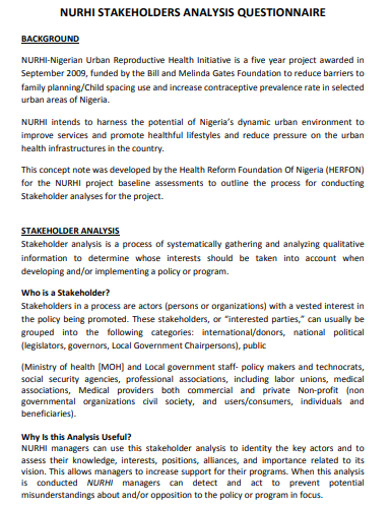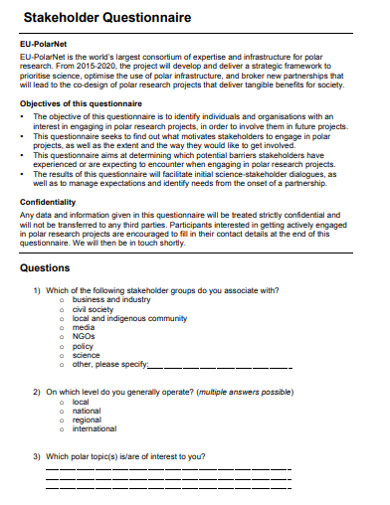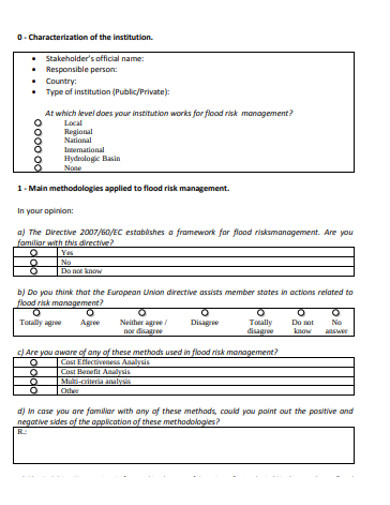3 Stakeholders Analysis Questionnaire Examples to Download
Some good-natured projects flop because stakeholders do not see how they will gain from spending and supporting these initiatives. Compliance with these proposals might cost more than what the company gains. And for a business, that is essentially losing more and more money with no promise of returns. Once there is an idea, project managers first figure how they can reconcile the interests of the organization and the stakeholders with the project’s benefits. Through stakeholder analysis, the project team is a step closer to making the project happen.
Stakeholders are individuals and groups who share in the influence and impact of the project. They could be the members of your organization, the project sponsors, or the project consumers. In every decision and choice made, stakeholder interest must also be considered. The team directly responsible for the project must remember that it is not always about them and their preferences. They also have to act for the people who have just as much influence on the project but are not in the room to represent themselves. Therefore, the team must perform stakeholder analysis to know who the project stakeholders are, how they influence the project, and how their interests can be best represented.
These people are important for the success of your project because they play a role in project development, marketing, and distribution. They are the ones responsible for providing you the resources to get started. They are the ones who are building the products. They are the people who will buy the result. If your project’s rationale and process don’t sit well with your stakeholders in its early stage, you can’t get it up and running. Therefore, you have to consider the interest of these people.
Stakeholder analysis questionnaires are documents with prepared questions about the project and the people involved. They are filled in by the people themselves. The answers that you will obtain from the documents will help the project team strategically address the needs of the stakeholders. The questionnaires make it easy for the team to identify the interests and work out the glaring differences to make the project benefit everyone.
There are promising plans that do not make it past the project proposal stage. The proponent became engrossed in making the paperwork become the next big thing. So much so that he or she forgot that good-on-paper projects don’t always get the yes from the management. Your project must win the hearts of its stakeholders so that it will have the support it needs as you lobby for its approval. When you have the idea for a project, consult with the people who will have a significant influence on the project. It is still your idea, but the project has taken the form of what your stakeholders would also be interested in. You not only gain support, but you might also receive more resources for this for your project development.
Aside from knowing what would make your stakeholders support your project, it is also beneficial for you that you can successfully engage them in your proposition. You can do so when you understand what your stakeholders value. When you are still consulting with them, get a feel of how they are responding to the idea. Are they enthusiastic or reserved about it? Based on your previous interactions with them, will there be a legal way that they might warm up to your proposition? The key to gaining their support would be to connect and relate with your stakeholders. Good stakeholder communication should be one of the team’s goals.
2+ Stakeholders Analysis Questionnaire Examples & Templates
Get a hold of the following stakeholder analysis questionnaire samples for your next project!
1. Sample Stakeholders Analysis Questionnaire Example
2. Simple Stakeholder Analysis Questionnaire Example
3. Formal Stakeholders Analysis Questionnaire Example
Facilitating Stakeholder Analysis
The stakeholders will influence the success of your project. Because you are vying for their support, you have to know how to get the influential people on board with your idea. You can do this with stakeholder analysis questionnaires.
1. List Down All Your Stakeholders
Create a list of individuals, groups, and organizations that will have a huge influence on your project. Include all the important people who will participate in the development and delivery of your project to its end. And this means a physical list so that you don’t miss out on important people. When you know who these personalities are, you can effectively manage your stakeholders and build good relationships with them.
2. Manage Priorities and Influences
Even though all these people and communities influence the project’s success, their contribution to and weight on the project vary to some degree. You can categorize the stakeholders based on their impact on your project. Prioritize the ones with the biggest influence and interest, while the ones with the lowest influence and interest can tag behind. Keep the key players satisfied and engaged in the project, since their approval of the project is pivotal in its success.
3. Speak the Influencer’s Language
Once you have identified your stakeholders and their level of influence in the project, you can communicate your project proposal with them in a way that would speak to their interest. If the person looks at the economic sustainability of an undertaking, shape your proposal to resound such. If the person puts the employees’ welfare at the forefront of any decision, you can highlight how the project approval can mean well for the people involved in it.
4. Meet Differences Halfway
This section will be about your team’s strategy on priority trade-offs that you will employ in every decision in the project. Because of the number of your stakeholders, there will be events that you will confront the differences. Instead of completely favoring one over the other based on your established stakeholder matrix, first consider if there is a way you can bridge these differences. Doing the former may make you lose the favor of those in that category. Do your best to come up with the best alternatives to keep your stakeholders satisfied and your project not losing its integrity.
The greatness of a project on paper would be useless if it isn’t translated in real life. No matter the end goal, when the project’s objectives and promised benefits do not align with the interests of your stakeholders, your idea will not exit the drawing board stage. You must understand the needs and interests of people who have power over your project’s success. With stakeholder analysis, you are closer to bringing your project to life.





